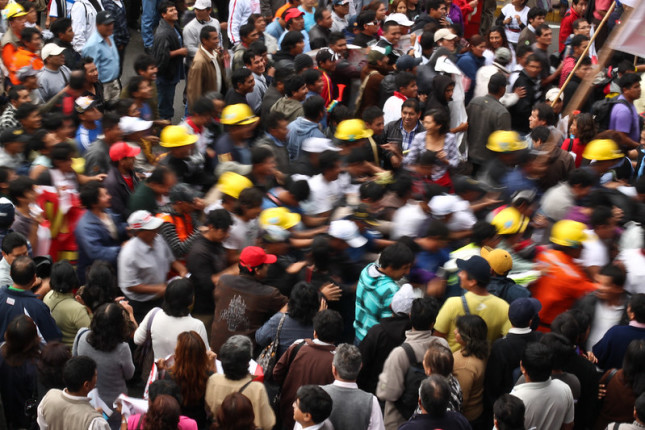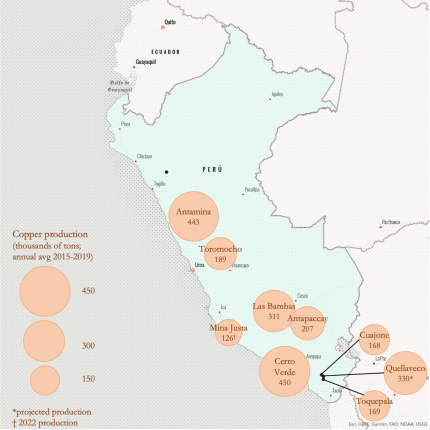-
Conflict and Copper
Global demand for copper has climbed dramatically in recent years, a trend that is likely to continue apace. Peru is the world’s second largest producer of copper. Yet the clamor for copper is an opportunity that the nation is unable to seize upon at present. Peru is now undergoing severe political upheaval and protests that have brought new attention to the underlying risks in extractive industries and supply chains. Production cuts stemming from protests and blockades could amount to 3 percent of global copper output.
Recent events in Peru only underscore the geopolitical implications of vulnerable global supply chains. They also remind us that social issues and conflict have long been intertwined with the extractive industries. Indeed, many of the same dynamics driving Peru’s current political crisis – income inequality, weak governance, rural mistrust and resentment of the capital, a sense of being left behind even as multinationals profit from local extraction – are the same factors that spark numerous social conflicts around mining.
Yet the turbulence around Peru and copper offer a chance for reflection and action. It is imperative to strengthen the tools to understand and navigate these political dynamics in order to obtain the materials necessary for modern economies as well as accomplish something even more important: a just transition that will bring fair benefits to rural resource regions and take the perspectives of their residents seriously.
Where Will the Energy Transition Find Copper?
Energy transitions towards low-carbon systems will be undergirded by huge amounts of copper. A recent meta-analysis of scientific literature projects global copper demand in 2050 to be 140 percent of the 2010 level, with further growth throughout the century. Supply shortfalls could begin in as little as three years, and persist at high levels for decades if dramatic steps are not taken to increase supply.
Where will this copper come from? The United States has ceded its historic position as a leading copper producer. And even if its industry leaders and lawmakers succeed in having copper designated as a critical mineral, the U.S. is unlikely to increase output on a scale anywhere near what is needed.
Meanwhile, other countries—including Peru—have increased in importance as potential sources. Peru has the world’s second largest copper reserves, and it has risen to its current position as the world’s second-largest copper producer over the last ten years. Its ascent has been accomplished as large new mines (Las Bambas, Toromocho, Quellaveco, Antapaccay, Mina Justa) came into production and existing mines completed major expansions (including Cerro Verde and Toquepala).
Social Conflicts: Is Dialogue Enough?
In the context of the renewable energy transition, the ability of countries like Peru to bring new copper mines online and maintain or expand output from current mines becomes a major concern. Peru’s recent burst in growth demonstrates that new projects can be developed successfully in that country. On the other hand, conflicts have frequently slowed or stopped Peruvian mining projects at all stages in the lifecycle.
The Las Bambas mine, which opened in 2016, faced a 50 day work stoppage due to local protests in 2022, leading to a 60 percent drop in production. The decades old Cuajone mine lost 54 days to local protests in 2022. The Tia Maria project has faced consistent opposition, calling into question if or when it will ever begin operations.
All of these protests predate the current political crisis. This reality underscores the growing recognition in the mining sector that social issues are as important as technical and economic concerns, and that the so-called “social license to operate” is a permanent relationship, rather than a one-time box checking exercise.
One near constant occupation for those who operate mines in Peru has been the necessity for dialogue with government and communities. A new study found that every large-scale mine in Peru had at least one officially recognized dialogue table in recent years. And 21 new mining dialogue tables were established on average every year. Notably, however, these channels for dialogue were commonplace for mines without major conflicts, as well as for those facing serious problems and stoppages. This suggests that while dialogue itself might be necessary, it certainly is not sufficient to successfully navigate complex relations between communities, the government, and companies.
Shared Value and Conflict Resolution
The urgency of the green transition and the growing role of nations like Peru in copper supply compel us to ask what lessons can be drawn from projects that do successfully navigate social challenges?
One key takeaway is that conflict resolution can be achieved by creating shared value through projects that are responsive to community demands, and even create a shared vision for development. This initiative stands in contrast to old models in mining operations that sought social license through top-down corporate philanthropy, and often failed.
For mines at Quellaveco and Cerro Verde, for instance, the shared value pathway centered on water – another key concern in Peru’s arid regions.
Quellaveco faced opposition in the 2000s from rural campesino and nearby urban communities, who objected to the mine’s planned water use. Things seemed to be at an impasse until a new dialogue process was initiated in 2011. The key breakthrough centered on the company’s agreement to build water infrastructure that would support irrigation projects in addition to supplying the mine. This change converted the community’s fears of harm to traditional livelihoods into a widespread view of the mine as a promotor of local agricultural development.
Cerro Verde’s expansion project demonstrated a similar dynamic, with neither an absence of controversy nor complete support, but, rather, the resolution of key sticking points through dialogue. Cerro Verde is located on the outskirts of Arequipa, a major city in southern Peru. Here again, water was a major concern. A novel solution emerged from the dialogue process, with local leaders convincing the company to build a sewage treatment plant and thus satisfy the mine’s water needs without diverting river water. Importantly, the plan also addressed a significant problem for the city, increasing the share of sewage being treated from 10 percent to 85 percent.
These two examples demonstrate how dialogue set the stage for companies working in Peru to resolve conflicts through the creation of shared value. But even as we highlight the lessons learned that can contribute to the social license to operate, it is important to recognize that conflict is a fact of life in many complex global supply chains. The current political crisis in Peru has brought new attention to these challenges, but many of the underlying dynamics that have created them are longstanding – and they are not unique to Peru. The transition to low-carbon energy systems will depend on understanding and managing these social dynamics.
Morgan Bazilian is professor and director of the Payne Institute at the Colorado School of Mines. He was previously lead energy specialist at the World Bank, and he is a Global Fellow at the Wilson Center.
Aaron Malone is a research associate at the Payne Institute at the Colorado School of Mines and a research assistant professor in the Department of Mining Engineering.
Eliseo Zeballos Zeballos is professor in the History and Social Sciences Department and director of the Faculty Development program at the Universidad Nacional de San Agustín de Arequipa, Peru.
Sources: Bloomberg News; Global Environmental Change; Mining; Ministerio de Energía y Minas, Peru; Peterson Institute for International Economics; Reuters; Resources, Conservation and Recycling; Resources Policy; S&P Global; Southern Copper Corporation; The Extractive Industries and Society
Disclaimer: The views and opinions expressed in this article are those of the authors and do not necessarily reflect the official policy or position of any agency of the U.S. government. Assumptions made within the analysis are not a reflection of the position of any U.S. government entity.
Photo Credit: A crowd of anti-mining protestors in Lima, Peru, courtesy of Flickr user Geraint Rowland.
 A Publication of the Stimson Center.
A Publication of the Stimson Center.





